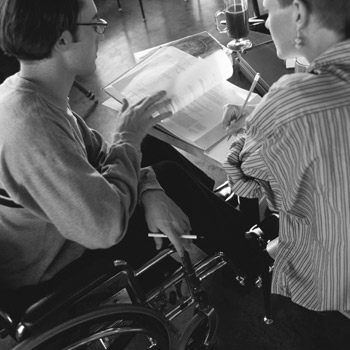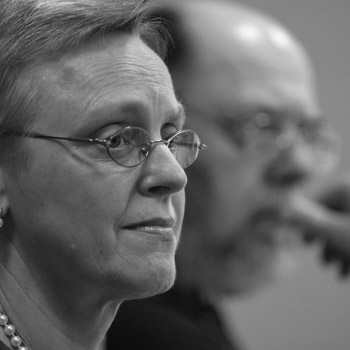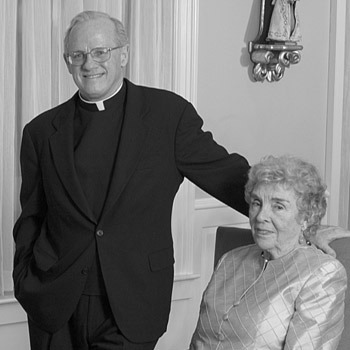It is a truism of organizational life: all things (good or bad) come to an end, including presidencies. Every year board members at twenty or so theological schools face the challenge of a presidential transition. How each board manages the sweet sorrow of the leader’s parting is critical to the future success of the man or woman who will follow.
In fact, as three veteran presidents (Ben Griffin, recently retired from the presidency of Andover Newton Theological School; Thomas Halbrooks, now in his last year at Colgate Rochester Crozer Divinity School; and Edward Wheeler, in his seventh year as president of Christian Theological Seminary) suggested over lunch with In Trust’s acting editor, succession planning is one of the board’s most important tasks. These longtime leaders point to the following three issues as a good place for boards to start in assuring a smooth transition from one president to another.
Be clear about the exit strategy. It may seem strange, or even slightly inhospitable, for board members to begin planning for the new leader’s eventual departure immediately upon his or her arrival at the institution. However, research shows that a significant percentage of presidential transitions are “non-routine,” catching the institution and/or the leader by surprise (see “Our president is gone,” New Year 2004). And even where the board has advance warning of a leadership change, presidential transitions are not easy. By addressing succession early, and continuing to revisit the issue from time to time, the board can head off potential trouble.
Many boards find it helpful to specify a contract period or term of office for the president. This creates a pre-arranged point for assessing the effectiveness of the president’s service and of the working relationship between the board and the head of the school. It is also an opportunity for trustees to restate their support of the president — to say aloud in the presence of the seminary community, “We still choose you.”
For presidents, the end of a term of service creates space for asking questions such as: Do I want to keep doing this job? Am I fully engaged with the work or do I feel my commitments lessening? Am I staying because I am not sure what else I might do, or because it is the right thing for the organization and for me? Organizational theorist Thomas Gilmore reminds us that there is a “striking linguistic similarity of the word ‘resign’ to the words ‘re-signing up,’ suggesting that when we re-sign up, we have had the courage to think of leaving.”
So it was for Ben Griffin as he neared in the end of a second term at Union Theological Seminary of the Twin Cities, a United Church of Christ school in New Brighton, Minnesota, and the first of his two stints in the president’s chair. Although he had told board members upon his arrival that he wasn’t likely to serve more than two terms, “only the chair seemed to remember,” he recalls with a laugh. His resignation came as a surprise to a lot of people, and all the more so because things were going well at the school.
For other presidents, including Ed Wheeler at Christian Theological Seminary in Indianapolis, Indiana, the review process fosters the courage to think of staying. As Wheeler puts it, “The good thing about terms is that there is a built in time for the institution and the individual to do some honest assessment of how things are going,” Now into his second five-year term, he reports feeling affirmed by the seminary’s board of directors. “There has been some reinventing of my role,” he states and that has him excited about the future.
Speak the truth in love. Rita Bornstein, a fourteen-year college president, warns that “longevity in office, in particular, can create a sense of omniscience and superior competence in a president.” Even newcomers to the presidency very quickly lose their objectivity when it comes to their own effectiveness. Every president can benefit from the wise counsel of relatively objective and caring advisors, and the most obvious place to look is to the board.
Some governing boards meet this responsibility with a committee on the care and nurture of the president, or as it is more simply called at Andover Newton Theological Seminary, the Committee on the President. Ben Griffin recalls with gratitude the committee’s support during his years at the Massachusetts school. “The members of the committee cared about me personally as well as professionally. They asked questions like how many weeks vacation had I taken. And they called my wife for an assessment of how I was doing,” he said.
It is the blessed president who can depend upon the board to speak the truth in love about his or her leadership. This includes when the message comes back that it is time to move on.
Manage the transition carefully. When Tom Halbrooks accepted the presidency of Colgate Rochester Crozer Divinity School, a school with historic ties to the American Baptist Churches in the USA and located in Rochester, New York, he knew he was stepping into a stressful job. He also knew he would need to be watchful for when the time would be right for him to leave. So early on he reached an agreement with the board that if either he or they began to feel a change was needed, each would give the other a year’s notice.
In May, Halbrooks acted on that agreement, meeting with the board chair to express his desire to retire from the presidency in the summer of 2005. “We had just completed work on a five-year strategic plan, and when I saw what it identified as the leadership needs of the school, I knew this was not for me,” he explains. Thanks to the early warning system agreed upon at the outset of his presidency, the board has had time for a careful and unrushed search for the school’s next president, and that is as it should be.
Francis Hasselbein, president and CEO of the Drucker Foundation for Nonprofit Management, reminds boards that how a presidential transition is handled “reveals the character and effectiveness of the leader, the organization, and its people … and presents remarkable opportunity to move forward with a new understanding of the complexities, challenges, and changes the organization must address.”
Although presidential leave-taking is almost always tinged with sadness, it is also a time to celebrate fruitful leadership and institutional accomplishments. There are ritual occasions that need to occur as a president exits from the seminary. People should have the opportunity to say thank you and to have some fun doing so.
Griffin adds, “If it has been a happy presidency, this is also a fundraising opportunity.” The board should pay special attention to key supporters during the transition period, reassuring friends of the seminary that the situation is under control and programs of the school are continuing as usual.
Maximize the president’s last days with the institution. Many presidents, fearful of the proverbial lame duck syndrome, put off announcing their retirement or resignation until the last minute. Leaders are aware that leaving is an occasion for both their own stocktaking and others’ summative evaluation of their tenure. But as Halbrooks notes, that doesn’t have to be a negative. “Once you’ve announced you are leaving, you can do some tough things that are for the good of the school, not just for your own career.” He adds that he plans to be fully engaged right to the end of his presidency.
Board members should be attentive to the president’s feelings as he or she watches the search process from the sidelines. “It’s tough to feel the excitement within the campus community as they anticipate a new leader, but this is normal,” Halbrooks notes. By assigning a committee to work with the outgoing president during the transition year, the board can help assure that his or her hoped-for legacy is achieved and that the school continues to benefit from the expertise and connections of the exiting leader.
Eventually, however, there is the final good-bye. All things (good or bad) come to an end, including seminary presidencies. The board’s responsibility is to manage the sweet sorrow of parting as gracefully as possible.
Boardroom Talking Points
→ What issues does this article raise about the preparedness of your board for a presidential transition?
→ How well has this board handled previous transitions?
→ What about the institution’s current situation might complicate a presidential transition?
→ What current conditions are most likely to present a challenge to the next president? What “skeletons” are hiding in the institutional closets?
→ What steps should the board take during the transition period to address potential trouble spots?
Read the entire “Life Cycle of a Successful Presidency” series
- In the beginning: The board’s role in welcoming the new president (Spring 2004)
- Timely and thoughtful does it: The board’s role in evaluating the president (Summer 2004)
- Guardians of the process: The board’s role in a presidential search (Autumn 2004)
- Managing the sweet sorrow of parting: The board’s role as the president leaves (New Year 2005)
See also:
Beginning well: After selecting a new president, the board’s next job is rolling out the welcome mat by Heather Grennan Gary When a new president signs on the dotted line, the board still has work to do — the president needs support in the transition.
This is the final installment in a four-part series on the life cycle of a successful presidency. The first article looked at the importanceof a strong beginningfor a new president.The second explored the board’s role in evaluating the president. In the third article, boards were encouraged to safeguard the presidential search process. In this last piece, board members are reminded that goodendings smooth the way for the next beginning.And so the cycle continues.




























